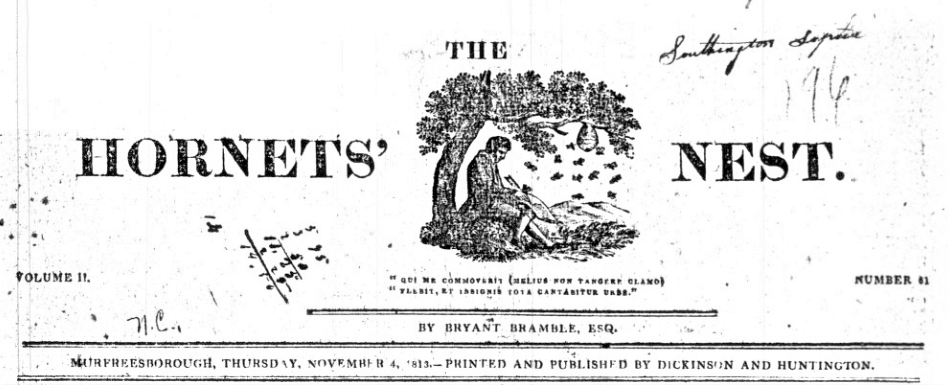
This week we have another 60 titles from all over the state up on DigitalNC, including a little piece of North Carolina railroad history!
On the second page of the January 15th, 1833 issue of the Fayetteville Observer, you’ll find a list of all the legislation enacted by the North Carolina General Assembly during the 1832-1833 session. One of these acts is the incorporation of the company that built North Carolina’s first functional railroad: The Experimental Rail Road Company of Raleigh.
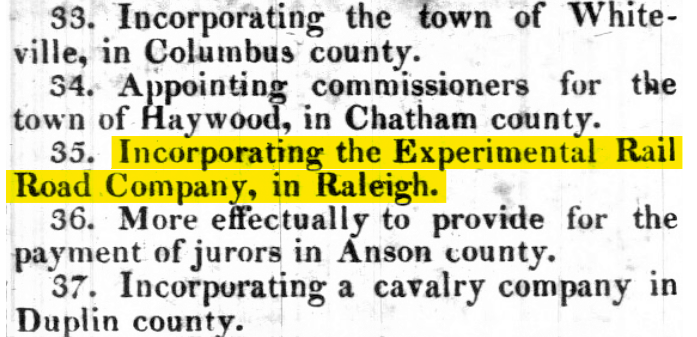
Fayetteville Observer, January 15, 1833
The one and one-quarter mile rail line extended from the Capitol Building, which had burned in 1831, to a quarry just east of Raleigh. When the horse-drawn rail carts weren’t transporting the stone used to rebuild the Capitol, people could ride the line in “pleasure cars” for a 25 cent fare. The line cost $2,700 to construct, which would be roughly $91,000 in 2022.
Over the next year, we’ll be adding millions of newspaper images to DigitalNC. These images were originally digitized a number of years ago in a partnership with Newspapers.com. That project focused on scanning microfilmed papers published before 1923 held by the North Carolina Collection in Wilson Special Collections Library. While you can currently search all of those pre-1923 issues on Newspapers.com, over the next year we will also make them available in our newspaper database as well. This will allow you to search that content alongside the 2 million pages already on our site – all completely open access and free to use.
This week’s additions include:
- The North Carolina Prohibitionist (Bush Hill, N.C.) – 1886-1888
- The Progress (Enfield, N.C.) – 1908-1922
- The North-Carolina Journal (Halifax, N.C.) – 1792-1810
- The News Reporter (Littleton, N.C.) – 1897-1923
- The Franklin Courier (Louisburg, N.C.) – 1872-1874
- The Madison Enterprise (Madison, N.C.) – 1873-1874
- The Monroe Journal (Monroe, N.C.) – 1923
- The Iredell Gazette (Mooresville, N.C.) – 1880
- The Morganton Herald (Morganton, N.C.) – 1891-1901
- Surry Visitor (Mount Airy, N.C.) – 1874-1876
- Cherokee Herald (Murphy, N.C.) – 1874-1876
- Person County Courier (Roxboro, N.C.) – 1890-1892
- North Carolina Argus (Wadesboro, N.C.) – 1848-1876
- Mecklenburg Times (Charlotte, N.C.) – 1889-1897
- The North Carolina Whig (Charlotte, N.C.) – 1863
- King’s Dollar Daily (Greenville, N.C.) – 1904
- King’s Weekly (Greenville, N.C.) – 1894-1909
- McDowell Democrat (Marion, N.C.) – 1905-1909
- Marion Progress (Marion, N.C.) – 1909-1922
- The Stanly Banner (Albemarle, N.C.) – 1876
- The Stanly Observer (Albemarle, N.C.) – 1884
- The Stanly News (Albemarle, N.C.) – 1892-1893
- The Caldwell Messenger (Lenoir, N.C.) – 1875-1876
- The Semi-Weekly News (Lenoir, N.C.) – 1900
- The Weekly News (Lenoir, N.C.) – 1900-1902
- The Magnolia Monitor (Magnolia, N.C.) – 1873-1876
- The Duplin Record (Magnolia, N.C.) – 1874-1875
- The Weekly Record (Magnolia, N.C.) – 1876-1877
- The Central (Lexington, N.C.) – 1876
- Lexington and Yadkin Flag (Lexington, N.C.) – 1855-1856
- The Lexington Herald (Lexington, N.C.) – 1915-1917
- The North State (Lexington, N.C.) – 1904-1908
- Murfreesboro Enquirer (Murfreesboro, N.C.) – 1876-1878
- The Albemarle Enquirer (Murfreesboro, N.C.) – 1878-1881
- The Hornets’ Nest (Murfreesboro, N.C.) – 1812-1813
- Carolina Chronicle (Murfreesboro, N.C.) – 1827
- Milton Intelligencer (Milton, N.C.) – 1819
- Milton Spectator (Milton, N.C.) – 1832-1839
- The Milton Chronicle (Milton, N.C.) – 1841-1888
- Milton Gazette & Roanoke Advertiser (Milton, N.C.) – 1824-1831
- The Milton Spectator (Milton, N.C.) – 1854
- The Lincoln Democrat (Lincolnton, N.C.) – 1895-1896
- The Lincoln Journal (Lincolnton, N.C.) – 1898-1901
- The Lincoln Courier (Lincolnton, N.C.) – 1891
- Lincoln Transcript (Lincolnton, N.C.) – 1836
- The Western Whig Banner (Lincolnton, N.C.) – 1840
- Lincoln Progress (Lincolnton, N.C.) – 1873-1882
- Economist (Elizabeth City, N.C.) – 1903
- The Weekly Economist (Elizabeth City, N.C.) – 1903-1905
- Daily Economist (Elizabeth City, N.C.) – 1905-1907
- North Carolina Advocate (Elizabeth City, N.C.) – 1833
- The Intelligencer, and Nag’s Head Advocate (Elizabeth City, N.C.) – 1840-1841
- The Elizabeth-City Gazette, and Public Advertiser (Elizabeth City, N.C.) – 1808
- Fayetteville Observer (Fayetteville, N.C.) – 1833
- The Public Spirit (Fayetteville, N.C.) – 1876
- The News (Fayetteville, N.C.) – 1865
- The Fayetteville Daily News (Fayetteville, N.C.) – 1865
- The Weekly Courier (Fayetteville, N.C.) – 1860
- Fayetteville Examiner (Fayetteville, N.C.) – 1880-1883
- Daily Telegraph (Fayetteville, N.C.) – 1865
If you want to see all of the newspapers we have available on DigitalNC, you can find them here. Thanks to UNC-Chapel Hill Libraries for permission to and support for adding all of this content as well as the content to come. We also thank the North Caroliniana Society for providing funding to support staff working on this project.

This week we have added issues from 35 different newspaper titles! One of the titles we have is a paper from the now non-existent town of Buffalo Springs, North Carolina. According to this News & Record article, the Harnett County town ceased to exist when the turpentine industry in the area died out. But the intriguing thing about these papers isn’t the ghost of this town, it’s the man who wrote them: John McLean Harrington. Professor and author Michael Ray Smith penned this fascinating paper about Harrington and his newspapers, in which he writes: “Shortly before the Civil War, the son of an affluent Southern family began a journalism career unlike any in his community, his state, or even the nation and produced 305 handwritten newspapers, perhaps the greatest single output of handwritten newspapers by any American journalist.” Harrington had a subscription list of roughly 100 people and would painstakingly copy each individual paper by hand, even though printing presses were widely available at the time. In 1858, when Harrington was writing issues of The Nation, he was only 19 years old. The young man’s ambitions didn’t stop with just being a journalist. He also apparently worked as a bookkeeper, surveyor, educator, sheriff, and postmaster in Harnett County. While his accomplishments were quite impressive, he was also a man of contradiction. Smith writes this of the rural Renaissance man: “He talked of a partner but never revealed the colleague’s identity—if he indeed had one. He discussed the evil of drinking but died an alcoholic. He served as a member of the Confederate militia only to swear an oath that he would always remain a loyal Unionist. Perhaps Harrington tended to do or say whatever was expedient or expected at the time. Maybe he was himself just conflicted in numerous ways.”
Over the next year, we’ll be adding millions of newspaper images to DigitalNC. These images were originally digitized a number of years ago in a partnership with Newspapers.com. That project focused on scanning microfilmed papers published before 1923 held by the North Carolina Collection in Wilson Special Collections Library. While you can currently search all of those pre-1923 issues on Newspapers.com, over the next year we will also make them available in our newspaper database as well. This will allow you to search that content alongside the 2 million pages already on our site – all completely open access and free to use.
This week’s additions include:
- The Tri-Weekly Bulletin (Charlotte, N.C.) – 1865-1881
- Asheville Pioneer (Asheville, N.C.) – 1867-1869
- Weekly Pioneer (Asheville, N.C.) – 1870-1874
- The Carolina Eagle (Hickory, N.C.) – 1871-1872
- Mountain Messenger (Jefferson, N.C.) – 1873
- Battleboro Advance (Rocky Mount, N.C.) – 1871-1873
- The Weekly Ansonian (Polkton, N.C.) – 1876-1877
- The Southern Mail (Hillsborough, N.C.) – 1880
- The Carolina Republican (Lincolnton, N.C.) – 1848-1853
- Yadkin & Catawba Journal (Salisbury, N.C.) – 1828-1833
- The Journal (Salisbury, N.C.) – 1833-1834
- The Hornet (Bixby, N.C.) – 1908
- The Courier (Asheboro, N.C.) – 1922-1924
- The Asheville Democrat (Asheville, N.C.) – 1889-1891
- Monthly Gleaner (Asheville, N.C.) – 1894-1895
- Fuller’s Gleaner (Asheville, N.C.) – 1895-1896
- The Dispatch (Bessemer City, N.C.) – 1912
- The Carthage Blade (Carthage, N.C.) – 1887-1895
- The Central Times (Dunn, N.C.) – 1895
- County Union (Dunn, N.C.) – 1895-1899
- The Transylvania Hustler (Brevard, N.C.) – 1893
- The Brevard Hustler (Brevard, N.C.) – 1896
- The Western Carolina Democrat (Bakersville, N.C.) – 1888
- Roan Mountain Republican (Bakersville, N.C.) – 1876-1879
- The Nation (Buffalo Springs, N.C.) – 1858
- Cape Fear News (Fayetteville, N.C.) – 1915-1917
- Central Argus (Hamlet, N.C.) – 1880
- The Stanly Enterprise (Albemarle, N.C.) – 1903-1907
- The Albemarle Enterprise (Albemarle, N.C.) – 1912-1916
- The Stanly News-Herald (Albemarle, N.C.) – 1920-1922
- The Beaufort News (Beaufort, N.C.) – 1920-1922
- The State Dispatch (Burlington, N.C.) – 1908-1909
- Daily Carolina Times (Charlotte, N.C.) – 1864-1869
- The Standard (Concord, N.C.) – 1900-1902
- The Battleboro Progress (Battleboro, N.C.) – 1880
If you want to see all of the newspapers we have available on DigitalNC, you can find them here. Thanks to UNC-Chapel Hill Libraries for permission to and support for adding all of this content as well as the content to come. We also thank the North Caroliniana Society for providing funding to support staff working on this project.
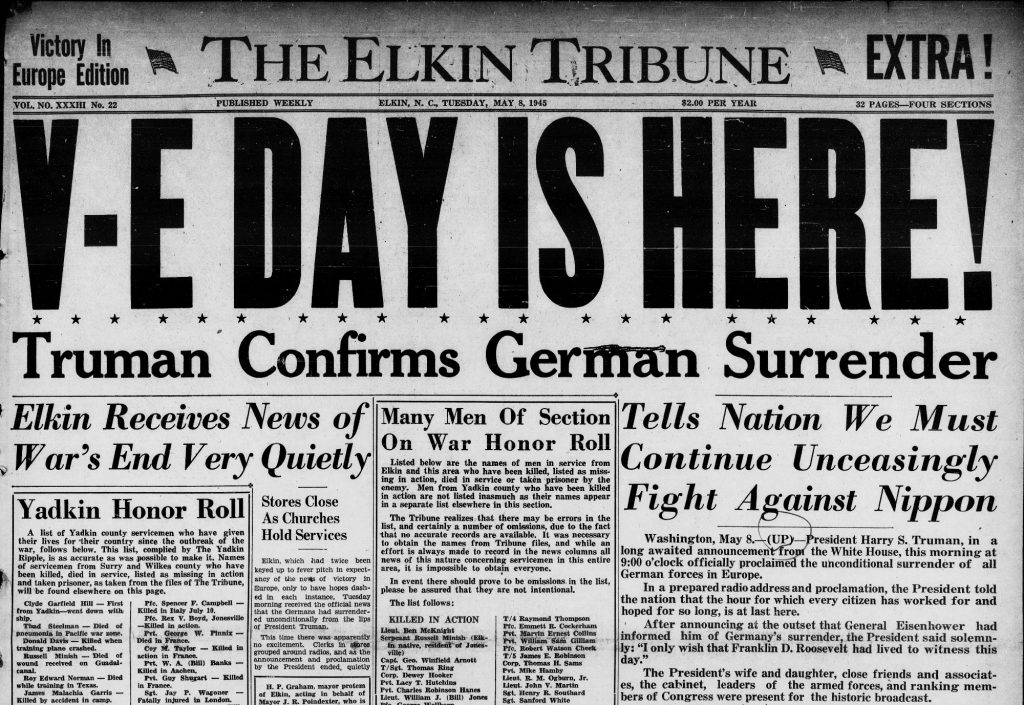 We’re pleased to share that you can now search more issues of the Elkin Tribune on DigitalNC, thanks to a nomination from the Elkin Public Library. The years added span 1916-1949, but the majority of the issues are from 1942-1949, with only a few scattered issues from the earlier years.
We’re pleased to share that you can now search more issues of the Elkin Tribune on DigitalNC, thanks to a nomination from the Elkin Public Library. The years added span 1916-1949, but the majority of the issues are from 1942-1949, with only a few scattered issues from the earlier years.
In the issues added from 1931 you’ll see a lot of coverage of the new Hugh Chatham Memorial Hospital, which still operates in Elkin today. The issues from 1942-1949 cover World War II and its immediate aftermath. There are lists of individuals who served from both Surry and Yadkin counties in the May 8, 1945 issue linked at the beginning of this post.
You can view all of the issues we’ve published from The Elkin Tribune on the newspaper’s landing page. To view all of the items we’ve worked on relating to Surry County, check out the county’s landing page.
A new video has been digitized and added to DigitalNC, courtesy of our partner, Davie County Public Library. The original 16mm film shows Dr. S. Clay Williams Jr. walking around the garden at Willsherr Lodge on Win-Mock Farm in uniform in 1945. Click here to view the film.
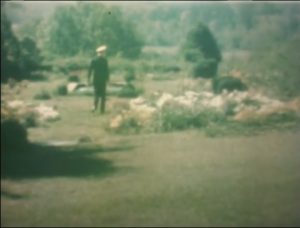
A frame from the video, showing Dr. S. Clay Williams Jr walking in the garden
Win-Mock Farm is a plot of land along the Yadkin River built by S. Clay Williams, president of the R.J. Reynolds Tobacco Company, located halfway between Winston-Salem and Mocksville. The Willsherr Lodge acted as the large family home, which is very briefly visible in the film.
To learn more about Win-Mock Farm, their website is here. To see more materials from Davie County Public Library, visit their partner page, or take a look at their website.
Architectural drawings of Cooleemee Plantation House and a 19th century map of North Carolina from Davie County Public Library have been added to DigitalNC.
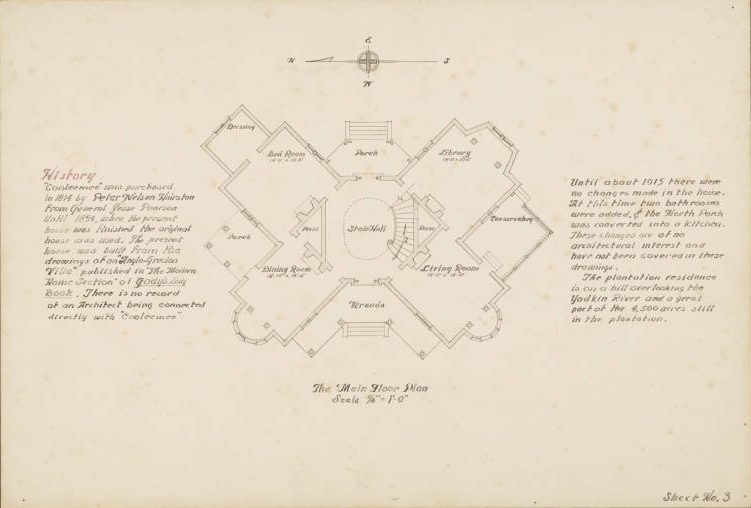
Cooleemee Plantation House architectural drawing of the main floor plan.
The Cooleemee Plantation House is between Lexington and Mocksville, North Carolina alongside the Yadkin River. Built based on drawings in Godey’s Lady’s Book, the house was completed in 1854. The Hairston family has owned Cooleemee and the plantation since 1814, and in 1978 Cooleemee was dedicated a U.S. National Historic Landmark due to its architecture. There are five architectural drawings of the Cooleemee Plantation House, completed in 1941 by John Erwin Ramsay. One (above) shows the main floor plan, another shows the second floor plan, two depict the front, back, and side of the house, and the last has details of doors, columns, cornices, and ceilings. There are also two photographs of the exterior and interior of the house as part of the plans.
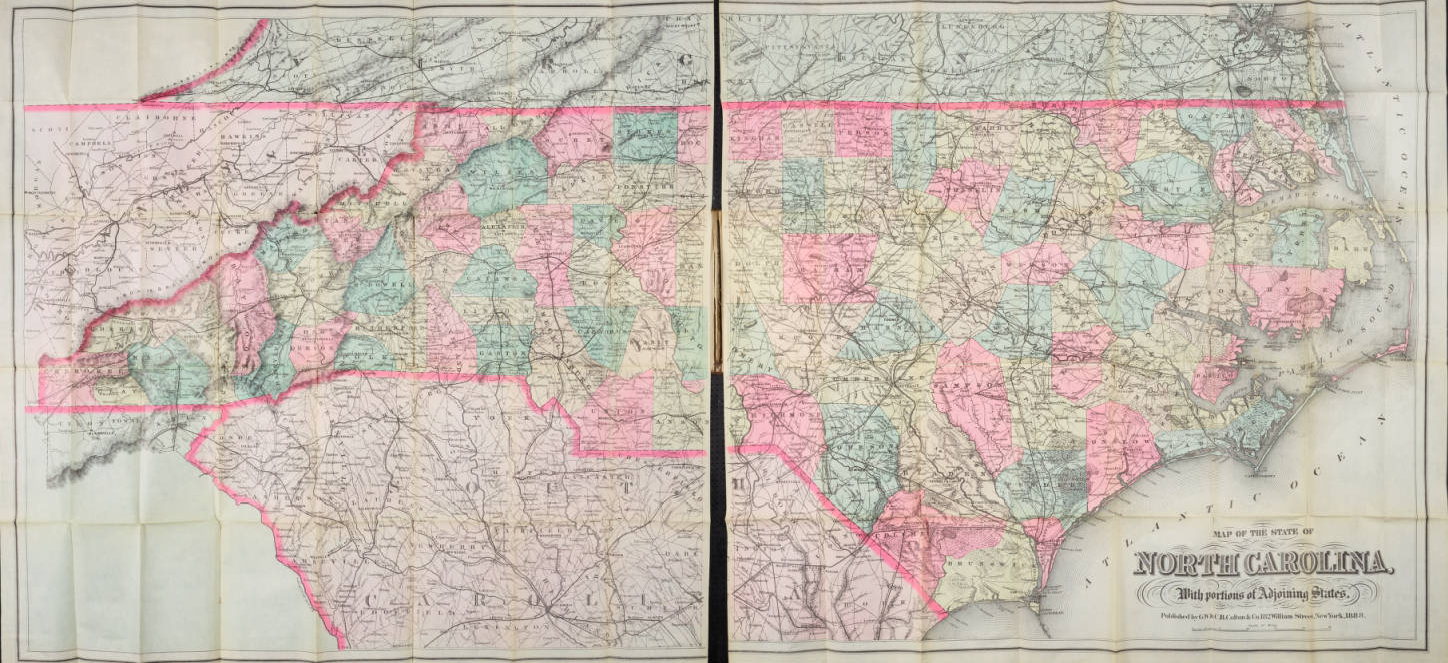
Colton’s Map of the State of North Carolina, 1888.
Also from Davie County Public Library is Colton’s Map of the State of North Carolina. This large fold out map of North Carolina was published in 1888. It depicts North Carolina divided by county (as well as parts of South Carolina, Tennessee, and Virginia) and shows mountains and rivers as well as cities, towns, and roads.
To see more items from Davie County Public Library, visit their contributor page or website.
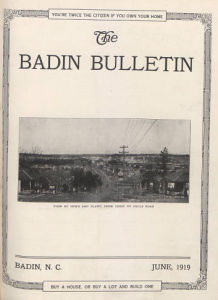 We’ve recently completed digitization of issues of the Badin Bulletin from 1918-1920, from the collections of the Stanly County Museum, which give a interesting glimpse into life in a factory town in the early 20th century.
We’ve recently completed digitization of issues of the Badin Bulletin from 1918-1920, from the collections of the Stanly County Museum, which give a interesting glimpse into life in a factory town in the early 20th century.
The town of Badin was formed in 1913 by a French aluminum company to house workers for a large plant being built on Yadkin-Pee Dee River. The outbreak of World War I derailed the French effort and the plant was purchased by the Aluminum Company of America (ALCOA). Although the town retained some of its original French influence, the collection of small houses grouped near the factory resembled the textile mill villages that were then prevalent throughout Piedmont North Carolina.
When the United States entered the World War, local demand for aluminum was high. As the factory expanded, so did the town. The Badin Bulletin documents civic and social life in the community from 1918-1920. It’s definitely a company paper — there are no stories about labor unrest or worker dissatisfaction — but it still provides an interesting look at the lives and activities of the workers. Much of the paper is devoted to news of the employees and their families, especially marriages, births, and deaths. There is a lengthy social column noting the visits and illnesses among the community and most issues are interspersed with patriotic articles and features about the factory itself.
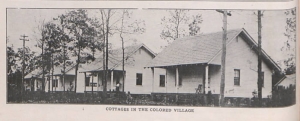 Most issues also include news from the local African American community. Like much of the South during this time, Badin was strictly segregated by race. The editors of the Badin Bulletin presented stories about the local “Colored Village” as if it were a source of pride for the company. Several issues include photos of houses and public buildings in the African American section. This may have been part of an effort to attract more African American workers to the factory.
Most issues also include news from the local African American community. Like much of the South during this time, Badin was strictly segregated by race. The editors of the Badin Bulletin presented stories about the local “Colored Village” as if it were a source of pride for the company. Several issues include photos of houses and public buildings in the African American section. This may have been part of an effort to attract more African American workers to the factory.
Badin remained a small community closely tied to the aluminum plant until 2010, when Alcoa announced that the factory would be closed and the property redeveloped for future industrial use. Badin celebrated its Centennial earlier this year.









